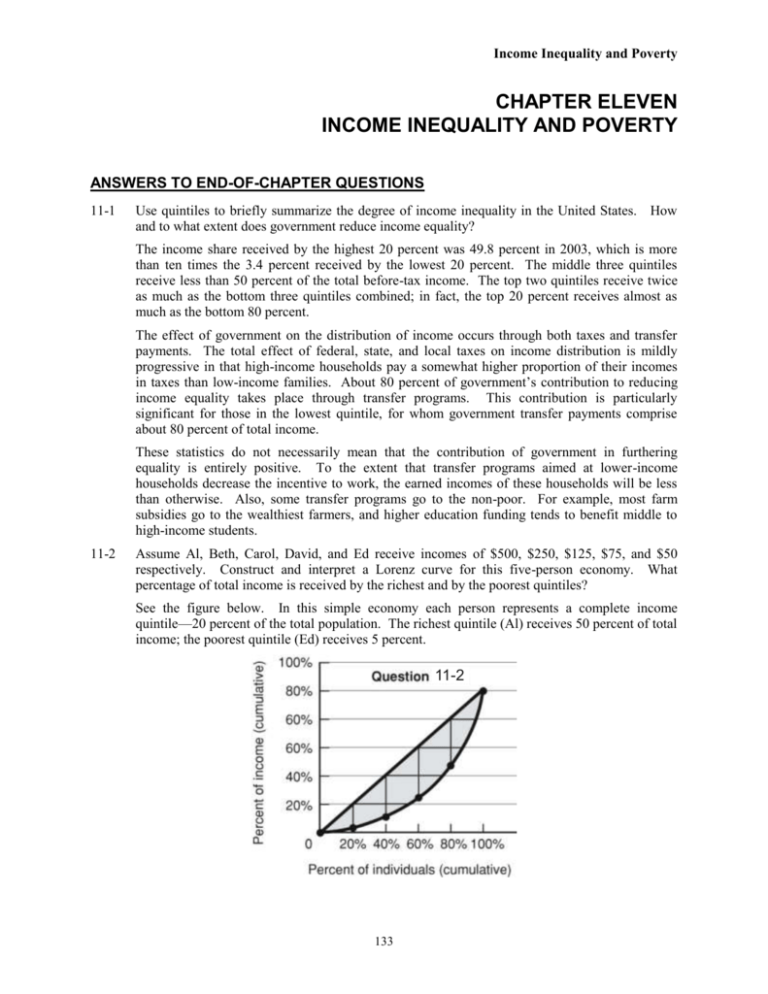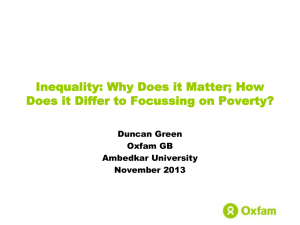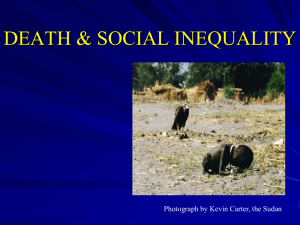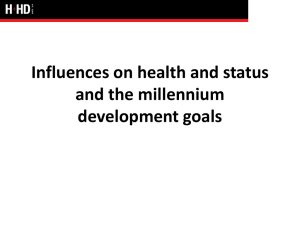chap011Answers
advertisement

Income Inequality and Poverty CHAPTER ELEVEN INCOME INEQUALITY AND POVERTY ANSWERS TO END-OF-CHAPTER QUESTIONS 11-1 Use quintiles to briefly summarize the degree of income inequality in the United States. How and to what extent does government reduce income equality? The income share received by the highest 20 percent was 49.8 percent in 2003, which is more than ten times the 3.4 percent received by the lowest 20 percent. The middle three quintiles receive less than 50 percent of the total before-tax income. The top two quintiles receive twice as much as the bottom three quintiles combined; in fact, the top 20 percent receives almost as much as the bottom 80 percent. The effect of government on the distribution of income occurs through both taxes and transfer payments. The total effect of federal, state, and local taxes on income distribution is mildly progressive in that high-income households pay a somewhat higher proportion of their incomes in taxes than low-income families. About 80 percent of government’s contribution to reducing income equality takes place through transfer programs. This contribution is particularly significant for those in the lowest quintile, for whom government transfer payments comprise about 80 percent of total income. These statistics do not necessarily mean that the contribution of government in furthering equality is entirely positive. To the extent that transfer programs aimed at lower-income households decrease the incentive to work, the earned incomes of these households will be less than otherwise. Also, some transfer programs go to the non-poor. For example, most farm subsidies go to the wealthiest farmers, and higher education funding tends to benefit middle to high-income students. 11-2 Assume Al, Beth, Carol, David, and Ed receive incomes of $500, $250, $125, $75, and $50 respectively. Construct and interpret a Lorenz curve for this five-person economy. What percentage of total income is received by the richest and by the poorest quintiles? See the figure below. In this simple economy each person represents a complete income quintile—20 percent of the total population. The richest quintile (Al) receives 50 percent of total income; the poorest quintile (Ed) receives 5 percent. 11-2 133 Income Inequality and Poverty 11-3 How does the Gini ratio relate to the Lorenz curve? Why can’t the Gini ratio exceed 1? What is implied about the direction of income inequality if the Gini ratio declines from 0.42 to 0.35? How would one show that change of inequality in the Lorenz diagram? The Gini ratio is the numerical measurement of the inequality depicted by the Lorenz curve. It is calculated by dividing the area between the curve and the diagonal by the total area below the diagonal. The Gini ratio can’t exceed 1 because if the Lorenz curve is as far as possible from the diagonal (line of equality), the area between the curve and the diagonal will equal the total area below the diagonal. The equality will result in a Gini ratio of 1. A decline in the Gini ratio implies less income inequality; and it would be graphically depicted by moving the Lorenz curve closer to the diagonal. 11-4 Why is the lifetime distribution of income more equal than the distribution in any specific year? The disparity of incomes in a single year reflects the income distribution at a point in time. The very young and very old will receive lower incomes, while the middle-aged tend to receive higher incomes, giving a picture of great inequality. However, if we view these same groups over time, there is considerable income mobility both up and down the income quintile groups, suggesting that income is more equally distributed over a five-, ten-, or twenty-year period for these same households. A Treasury Department study confirmed that the longer the time period considered, the more equal the distribution of income because there is “significant household income mobility over time.” 11-5 Briefly discuss the major causes of income inequality. What factors have contributed to greater income inequality since 1970? The reasons for income inequality are: differences in abilities and talents among individuals, differences in the amount of education and training an individual obtains, labor market discrimination, differences in tastes and preferences toward work and job attributes, inequality in the distribution of wealth, the ability to use market power to transfer income to oneself, luck, connections, and misfortune. Several factors have contributed to the increase in income inequality since 1970. The overriding factor is the structural changes that have occurred in the U.S. economy. There has been an increase in the demand for high-skill and well-educated workers relative to lesser-skilled workers. During the 1970s and 1980s less experienced, younger people entered the labor force in large numbers, thus reducing their incomes. There also was a rise in the number of single mothers with children, but few labor market skills. More recently, there has been a tendency for well-educated men and women to marry, thus placing these families in the highest quintile and increasing the income to those in that quintile. Increased divorce rates have tended to push female-headed households into poverty. Other structure changes include more import competition resulting in a reduction in the demand for and employment of less-skilled workers who used to command high-paying, often union, jobs in manufacturing and an increased the immigration of unskilled workers. 11-6 Should a nation’s income be distributed to its members according to their contributions to the production of that total income or according to the members’ needs? Should society attempt to equalize income or economic opportunities? Are the issues of equity and equality in the distribution of income synonymous? To what degree, if any, is income inequality equitable? The answer to this question is inextricably tied to value judgments, but most of us probably favor a combination of the two types of income distribution. A purely capitalist system, in which incomes are determined exclusively by the market mechanism, would mean that those who, for whatever reason, are unable to contribute to production would have to depend exclusively on 134 Income Inequality and Poverty private charity for their livelihood. A (hypothetical) communist state also leads to a seemingly intractable problem—if income is to be distributed purely on the basis of need, why would anyone engage in production? Most modern societies attempt to seek a compromise of one sort or another between these two extremes. The compromise that is actually found often differs markedly from what prevailing political rhetoric in that society might suggest. Socialist economies, which historically have had large differences in income distribution, also have wider-ranging government transfer programs than most capitalist economies. Conservatives contend that because of the tradeoff between equality and efficiency, society should content itself with attempting to ensure equality of opportunity. Liberals argue that income redistribution is essential since equality of economic opportunity is impossible in an economy with wide differences in income, especially when these differences are related to the inheritance of property. Income equity refers to how fairly income is distributed. One can argue that some inequality of income is not only necessary for reasons of efficiency but is fairer than an equal distribution of income, since those who produce more deserve to be rewarded for their efforts. But unequal incomes are not necessarily related to differences in individual ability or effort. It is difficult to defend the inequalities that result from market power and discrimination as being equitable. The justness of inherited wealth is also questionable. Liberals argue that by creating inequality of opportunity, property inheritance is inherently unjust. Conservatives contend that allowing individuals to pass on wealth to who they wish is much fairer than having wealth appropriated by the government. 11-7 Comment on or explain: a. Endowing everyone with equal income will make for very unequal enjoyment and satisfaction. b. Equality is a “superior good”; the richer we become, the more of it we can afford. c. The mob goes in search of bread, and the means it employs is generally to wreck the bakeries. d. Some freedoms may be more important in the long run than freedom from want on the part of every individual. e. Capitalism and democracy are really a most improbable mixture. Maybe that is why they need each other—to put some rationality into equality and some humanity into efficiency. f. The incentives created by the attempt to bring about a more equal distribution of income are in conflict with the incentives needed to generate increased income. (a) No distribution of income can ensure equal enjoyment. Using marginal utility theory, it can be argued that by equalizing incomes in an economy, there is the probability of maximizing total utility for all individuals. This assumes that everyone has identical diminishingmarginal-utility-of-money schedules. (b) The lessening of poverty provides a host of indirect benefits to affluent members of society—social peace, physical security, and perhaps the intangible satisfaction of living in a more equitable society. The better off the affluent become, the more they are willing to spend in order to purchase these benefits. (c) Mobs commonly exhibit a marked preference for present over future consumption. Many conservatives contend that the income redistribution schemes resulting from democratic decision making suffer from a similar failing by decreasing the incentive to accumulate capital in order to provide present consumption to the poor. Is this view valid? Perhaps. Does this mean that such redistribution schemes are misguided? Not necessarily. 135 Income Inequality and Poverty (d) This is a common conservative view, that civil and political liberties are more important than the universal eradication of poverty. Liberals are likely to contend that ensuring universal freedom from want does not necessarily detract from these fundamental freedoms. (e) The principles underlying the two systems can be summarized as follows: Each dollar has a vote in the marketplace, and each person has a vote at the ballot box. These principles are similar enough that the presence of one often leads to the other. They are dissimilar enough so that the type of society that arises from a combination of the two represents a workable social compromise. (f) Incentives created in the attempt to bring about more equal distribution of income may cause a tradeoff in decreased economic efficiency. Higher marginal taxes may reduce the efforts of those at the top to work harder and produce more. Greater benefits to those at the bottom may reduce their incentive to do the same as they receive benefits without the productive effort. In so far as this tradeoff occurs, there will be a reduction in economic growth and therefore, damage to incentives leading to increased incomes. 11-8 How do government statisticians determine the poverty rate? How could the poverty rate fall while the number in poverty rises? Which group in each of the following pairs has the highest poverty rate: (a) children or people age 65 or over? (b) African-Americans or foreign-born noncitizens? (c) Asians or Hispanics? The Federal government establishes minimum income thresholds for poverty based on family size. For example, in 2003, a single person receiving less than $9393 per year was considered to be living in poverty. To find the poverty rate, the number of people defined to be in poverty is divided by the total population. As of 2003: (a) Children have higher poverty rates than people 65 or over (17.6 v 10.2 percent) (b) African-Americans have higher poverty rates than foreign-born noncitizens (24.4 v 21.7) (c) Hispanics have higher poverty rates than Asians (22.5 v 11.8) 11-9 What are the essential differences between social insurance and public assistance programs? Why is Medicare a social insurance program, whereas Medicaid is a public assistance program? Why is the earned-income tax credit considered to be a public assistance program? Social insurance programs provide aid to those who are retired or suffering from temporary distress. They are usually financed through payroll taxes and are viewed to be earned rights because they are paid for by recipients. Public assistance programs provide benefits for those who are unable to earn income because of permanent handicaps or who have no or very low income and have dependent children. To receive assistance, an individual must pass a “means” test. The cash payments are paid for out of general tax revenues. Most of these revenues come from individuals other than the recipients. The Medicare program is a part of the Social Security program and is financed with a 2.9 percent tax on wage and salary earnings. Those who have reached 65 years of age are eligible to participate in the program. Medicaid is a program for individuals who are participating in the SSI and TANF programs. It is financed from general tax revenues and is available only to qualified individuals. 136 Income Inequality and Poverty The earned-income tax credit is considered a public assistance program because it is targeted at low-income families. 11-10 What major criticisms of the U.S. welfare system led to its reform in 1996 (via the Personal Responsibility Act)? How did this reform try to address these criticisms? Do you agree with the general thrust of the reform and with its emphasis on work requirements and time limits on welfare benefits? Has the reform reduced U.S. welfare rolls or increased them? The major criticisms of the old welfare system (AFDC) was that it was not ending poverty although billions of dollars were being spent, that the number of people in poverty was increasing, and that it was creating a dependency on the government by those participating in the program. The new program (TANF) sets a 5-year lifetime limit on the participants and requires ablebodied adults to work after receiving assistance for 2 years. It ended food-stamp eligibility for able-bodied person aged 18 to 50 years (with no dependents) who are not working or engaged in a job-training program. It tightened the definition of “disabled children” relative to eligibility for SSI assistance. And finally, it established a 5-year waiting period for new immigrants who are not citizens to receive assistance. Economic security and self-sufficiency are two goals that are best for individuals as well as for the economy as a whole. The new TANF will help to achieve both of these goals, hopefully without causing undue hardship particularly for children. The reform, along with strong labor demand and low unemployment, reduced the number of welfare recipients from 12.6 million in 1996 to 5.2 million in 2002. 137









